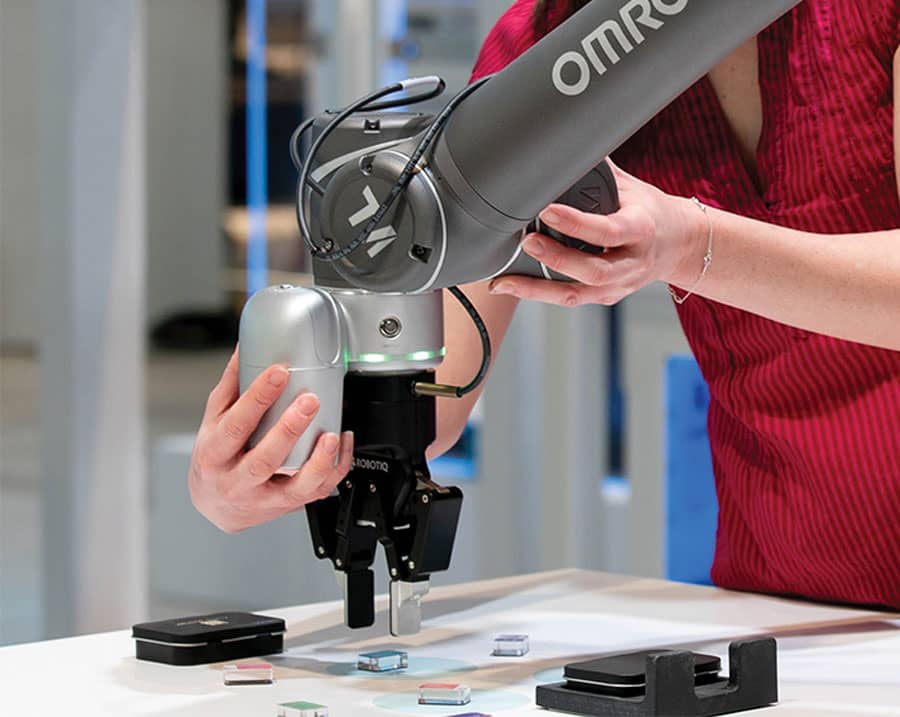What are Collaborative Robots or Cobots and what are they used for?
The first cobot or collaborative robot was invented in 1997 by two Northwestern University professors, as a software programmable robotic manipulator and assist devices that can directly interact with a human operator. Collaborative robots were designed to work alongside humans in a collaborative workspace, hence the name “collaborative robot” or cobot for short.
This collaborative environment is what sets cobots apart from conventional industrial robots, which have powerful and potentially dangerous actuators that are designed to operate at high speeds and carry heavy payloads. Because of the danger, people are usually barred (with safety cages, fencing, etc.,) from entering the industrial robot’s workspace. Cobots don’t need safety barriers. Instead, they are equipped with sensors that stop the robots movement when a person or obstacle gets too close or enters their workspace.
Cobots were developed for the purpose of performing routine or repetitive tasks, like placing finished products into boxes, or performing dirty or dangerous jobs, like sanding or sorting trash for recycling. Unlike humans, cobots can perform the same movement and operation over and over, with maximum precision. They can work 24 hours a day, 7 days a week, including holidays. By using cobots for continuous and tedious tasks, the health and safety of human workers is improved, and accidents and repetitive motion injuries are decreased.
Cobots are also a great solution for the labor shortage issue.
Because of their affordable price point, small and medium sized enterprises are able to reap the benefits of bringing automation to their manufacturing facility or to the shop floor. And cobots have proven to deliver a fast ROI. They can be easily reprogrammed to do different tasks and have a small footprint of mere inches. Mobility is another benefit. Because cobots are light weight, they can be redeployed for multiple applications without the need to change production layouts. And they require far less power to operate than industrial robots.
What makes cobots so exciting is the simplicity of programming. It’s not difficult to program collaborative robots to perform most manufacturing tasks and requires no previous programming experience.
The collaborative robot market continues to grow and there are many more choices than a decade ago. Omron’s TM series stands out from the pack because it offers an all-inclusive solution. The TM Series is the only cobot on the market with a built-in vision system, which allows users to set up vision tasks for immediate deployment without going through the hassle of spec’ing and integrating external cameras, lighting equipment, or software. By giving cobots ‘eyes’ to see, they’re able to sense their environment and the humans working alongside them. From quality inspection and code reading to bin sorting and palletizing, the TM Series makes deployment for vision related tasks easy. You can learn more about the TM Series here.
Collaborative robots are safe, flexible, mobile, can be easily reprogrammed for new tasks, cost less than conventional robots and have a fast ROI. Cobots can increase the overall productivity and efficiency of an operation, as well as improve safety and quality. In many cases, they can also lower labor costs. And they alleviate human workers from performing dirty, dangerous, heavy, or repetitive work.
If you’d like to learn more about collaborative robots for your operation, contact an MSI TEC robotics engineers.

Be the first to learn about classes, training, webinars, products news and more.
©2025 MSI TEC, Inc ALL RIGHTS RESERVED
©2025 MSI TEC, Inc ALL RIGHTS RESERVED
We use only necessary cookies on this website to provide the best user experience and customer service.